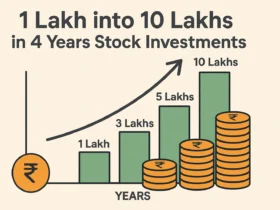Starting with Rs 500 a month in a SIP plan is a smart way to grow your wealth. It offers the chance for long-term growth and wealth creation1. SIP plans are popular because they use compounding to grow your money over time. They are a good choice for many people looking to invest.
They help spread out the cost of investing, which is great when the market is up and down2.
Table of Contents
A SIP plan can give you about two times the returns of Fixed Deposits (FDs) and Recurring Deposits (RDs)2. You can start with just Rs. 500 a month2. Putting in Rs 500 monthly could lead to a 12% return each year3.
Key Takeaways
- Investing in a SIP plan with Rs 500 per month can provide long-term growth and wealth creation.
- A systematic investment plan can generate about two times the returns compared to standard Fixed Deposits (FDs) and Recurring Deposits (RDs)2.
- The minimum investment for a SIP is Rs. 500 per month2.
- Investing Rs 500 per month in a SIP plan can provide financial outcomes, with an expected return rate of 12% per annum3.
- SIP plans can help average out the cost of investment over time, which is beneficial during market fluctuations2.
Understanding the Power of Small Investments
We often think small investments don’t matter, but they really do. Every rupee can help grow your wealth4. By investing a little each month, you can build a lot of wealth over time. For example, putting in Rs 500 monthly through SIPs can grow into a big amount in 10-20 years5.
Starting early and sticking to it is key to building wealth. SIPs help by averaging out the cost of investments. This means you buy more when prices are low and less when they’re high4. It’s a smart way to reach your financial goals, like saving for retirement or a big buy. Plus, SIPs let you adjust your investment based on your money situation5.
Small investments can lead to big returns. For instance, saving Rs 1,000 monthly for 20 years can grow to Rs 7,18,259, assuming a 10% return4. Or, saving Rs 500 monthly for 30 years could grow to Rs 1,764,957 with a 12% CAGR6. These numbers show how small investments can add up and why starting early is so important.
In short, small investments can make a big impact on your wealth. By investing a little regularly and using the power of compounding, you can reach your financial goals5. So, remember, every rupee and every month matters4.
What Makes SIP the Ideal Investment Choice
We see SIP as a top choice for investing because of its flexibility and growth chances7. You can start investing with just Rs 500 a month, making it easy for many to join in8. The way SIP works, by investing the same amount every month, helps lower your costs over time8.
SIP helps you invest regularly, which can lessen the ups and downs of the market7. You can choose how often to invest, like weekly or yearly, based on what works best for you8. This flexibility makes SIP a great pick for those new to investing in stocks.
Studies show that SIP can lead to big returns, often 2x more than other investments9. For instance, putting in Rs 5,000 monthly for 30 years can grow to Rs 1,58,49,5699. This shows SIP’s power as a long-term investment.
Best SIP Plan for Rs 500 per month: Our Top Recommendation
Investing Rs 500 a month in a top SIP plan is a smart move. The Nippon India Small Cap Fund stands out, with an AUM of ₹61,974 Crs1 and a highest annual return of +557.6%1. It balances risk and returns well, appealing to many investors.
A diversified portfolio is key for any investment. The Nippon India Small Cap Fund offers this. With a minimum SIP investment of Rs 500 per month10, it’s open to many. Starting with just Rs 500 per month4 makes it perfect for beginners.
Some top benefits of this SIP plan include:
- Rupee cost averaging, which helps manage market risks4
- Disciplined investing, which means less need for constant market checks4
- Potential for long-term wealth, with returns from +10.39% to +30.55%1
Investing in a top SIP plan like the Nippon India Small Cap Fund can lead to high returns. Some funds offer average annual returns of +27.20%10 or more. With a good strategy, Rs 500 a month can help you reach your financial goals.
Benefits of Starting Your Investment Journey with Rs 500
Starting with Rs 500 per month can lead to long-term growth and wealth creation11. Early and consistent investing can harness the power of compounding. This can build a large amount of wealth over time12.
Investing Rs 500 regularly can grow into a significant amount. This shows the power of compounding12.
The main advantages of starting with Rs 500 include:
- It helps in developing discipline and regularity in financial planning11.
- It offers rupee cost averaging benefits, which are great for managing market ups and downs11.
- Starting early with SIPs can lead to better returns over a long period12.
Remember, consistency is key when starting with Rs 500. Avoiding SIPs during market downturns can reduce the benefits of systematic investing12. By understanding these benefits and staying committed, we can achieve long-term financial success.
With the right mindset and strategy, investing Rs 500 can lead to significant gains11. Let’s begin our investment journey with Rs 500. This way, we can enjoy the rewards of early and consistent investing12.
Understanding the Mathematics Behind Your SIP Growth
To grasp SIP growth, it’s key to look at expected returns and how time affects your investment13. The formula for SIP returns is A = P × {[1 + r]^n – 1} / r × (1 + r). Here, A is the final amount, P is the monthly investment, r is the monthly return rate, and n is the number of months invested14.
Compounding is a big part of SIP growth15. It can greatly increase your investment over time. An expected returns calculator helps you predict your future wealth and guides your investment choices.
Here’s an example of SIP growth:
| Monthly Investment | Expected Annual Return | Total Investment | Projected Total Value |
|---|---|---|---|
| ₹500 | 12% | ₹3,00,000 | ₹4,12,000 |
Understanding SIP growth math helps you make smart investment choices. This way, you can reach your long-term financial goals13.
Key Features to Look for in a Rs 500 SIP Plan
When picking a SIP plan for Rs 500 a month, look at a few key things. These include the team managing the funds, the risk levels, and the possible returns16. These factors help you pick a plan that fits your goals and how much risk you’re okay with.
A SIP plan lets you invest small amounts often. This can help grow your wealth over time17. You can start investing in mutual funds with just Rs. 50016. After 10 years, with Rs. 500 monthly, you could have Rs. 60,000 invested. And with a 12% return, you could have over Rs. 1.15 lakh16.
When choosing a SIP plan, consider a few things:
- The team managing the funds and their experience
- The risk levels and possible returns
- How long you plan to invest and if you can change your investment
- Getting advice from certified financial advisors
A table summarizing the key features of a SIP plan is as follows:
| Feature | Description |
|---|---|
| Fund Management Team | Experienced team with a proven track record |
| Risk Levels | Low to high risk options available |
| Potential Returns | Assumed 12% annual return |
| Investment Horizon | Long-term investment option |
By looking at these features, you can choose a SIP plan that meets your needs18.
Step-by-Step Guide to Starting Your SIP
To start your SIP journey, knowing the process is key. A step-by-step guide makes it easy. You’ll need to meet KYC requirements, which can be done online, making things simpler19.
Setting up your account requires some documents like your PAN and Aadhaar cards. You’ll also need your bank details. After setting up, you can start your SIP by linking it to your bank account19. This way, you buy more units when prices are low and less when they’re high, which helps with market ups and downs19.
Here’s how to start your SIP:
- Check the document requirements and ensure you have all necessary documents
- Complete the account setup process and provide required information
- Set up auto-debit instructions for your SIP
The minimum you can invest in a SIP is Rs 500 a month10. This small amount can grow a lot over time19. By following this guide, you can start your SIP and begin investing.
For instance, if you earn ₹70,000 a month and invest ₹20,000 in SIP, you’ll invest ₹48 lakhs in 20 years. With a 15% return, you could have over ₹3 crores20. Knowing what documents you need and following this guide helps you make smart investment choices and reach your financial goals.
| Investment Amount | Time Period | Projected Corpus |
|---|---|---|
| ₹20,000/month | 20 years | over ₹3 crores |
Tax Benefits of Your Rs 500 SIP Investment
Investing in a Systematic Investment Plan (SIP) can save you money on taxes. It can lead to tax savings and exemptions21. Knowing how SIPs affect taxes helps you make smart choices and lower your tax bill. For example, investing in Equity Linked Saving Schemes (ELSS) through SIPs can get you a tax deduction of up to Rs. 1.5 lakh under Section 80(C) of the Income Tax Act21.
If you’re in the highest tax bracket (30%), you could save Rs. 45,000 a year with SIP investments in ELSS21. SIPs are in the EEE (Exempt, Exempt, Exempt) category. This means your investment, the money it grows to, and any withdrawals are all tax-free21. You can start investing in ELSS SIPs with as little as Rs. 500 a month21.
Some key benefits of SIP investments include:
- Flexibility in investment amount and tenure
- Potential for long-term financial growth
- Disciplined savings habits
- Tax benefits, such as exemptions and deductions
It’s important to remember that SIP investments can greatly reduce your tax burden while helping your wealth grow21. Online platforms make it easy to find and invest in tax-saving SIPs22.
Common Mistakes to Avoid When Starting a SIP
Starting a Systematic Investment Plan (SIP) requires knowing common mistakes. One big mistake is timing the market wrong, which can harm your investments23. Another error is making investments irregularly, which messes up the SIP’s compounding effect12.
Not setting clear goals is another mistake, leading to unrealistic hopes23. To avoid these, it’s key to set goals, invest regularly, and skip market timing. This way, you can reach your investment goals and maximize your SIP benefits.
Some important tips for starting a SIP include:
- Start with a minimum investment amount, such as Rs. 500 per month23
- Invest regularly to use compounding’s power12
- Don’t try to time the market, as it can cause bad investment choices23

Knowing these common mistakes and avoiding them can help you succeed with your SIP. Always research, set clear goals, and invest regularly to meet your investment targets24.
| Mistake | Consequence |
|---|---|
| Timing the market | Poor investment decisions23 |
| Irregular investments | Disrupted compounding effect12 |
| Lack of goal setting | Unrealistic investment expectations23 |
Monitoring and Managing Your SIP Investment
As we journey through investing, it’s key to keep an eye on our SIP investment. We should track the fund’s performance, rebalance our portfolio, and adjust as needed25. This way, we can stay on track with our investment goals and tweak our strategy when necessary. For example, investing in funds with high Compound Annual Growth Rates (CAGR) like the ICICI Prudential Smallcap Fund with a CAGR of about 13.51%26 can be beneficial.
When checking on our SIP investment, we need to think about our goals, how much risk we can take, and when we plan to cash out. We should also watch how our chosen fund is doing and make changes if needed. This might mean switching funds or changing how much we invest. Studies show that investing a set amount, like Rs 500 each month, can help smooth out market ups and downs25. Also, mixing equity and debt funds in our portfolio can help us reach our long-term goals26.
Some key benefits of keeping an eye on and managing our SIP investment include:
- Improved investment performance
- Reduced risk
- Increased returns
- Better alignment with our investment goals
By regularly checking and managing our SIP investment, we can make smart choices and adjust our plan as needed to meet our financial targets.
It’s also vital to remember the power of regular investing in SIPs. Investing the same amount regularly can help us benefit from compounding and lessen the effects of market swings25. By making informed decisions and keeping a close eye on our SIP investment, we can make sure our portfolio matches our financial goals and risk level.
When to Increase Your SIP Amount
As we journey through investing, it’s key to know when to boost our SIP amount. A big increase in income is a clear sign to put more money into our investments27. Also, if our investment goals shift, we might need to up our SIP amount to meet these new targets28.
Scaling up our SIP investments can be done in a few ways. One method is to up the SIP by a set percentage, like 10%, every six months1. Another is to invest a fixed amount regularly, which helps smooth out market ups and downs27. It’s also wise to regularly check and tweak our investment mix to match our evolving goals and comfort with risk.
When looking to increase our SIP, some good options include the Nippon India Small Cap Fund and the Invesco India PSU Equity Fund. The Nippon India Small Cap Fund has a big AUM of ₹61,974 Crs and a return of +30.55% per year1. The Invesco India PSU Equity Fund has an AUM of ₹1,286 Crs and a return of +24.32% per year1. By recognizing the right time to increase our SIP and using smart strategies, we can grow our wealth and reach our financial dreams.
The secret to successful SIP investing is to be steady, patient, and well-informed. By sticking to these principles and staying true to our investment goals, we can maximize our SIP’s power and reach financial freedom.
Alternative Investment Options at Rs 500
Looking to invest Rs 500? There are many options to consider. Mutual funds, stocks, and fixed deposits all have their own benefits and risks29. For example, Bajaj Finance has seen returns over 44.1% in the last 15 years29. This makes it a great choice for those seeking high returns.
Investing in equity mutual funds is another option. They can start with as little as Rs 10029. The National Pension Scheme (NPS) also offers tax benefits, with a maximum deduction of Rs 1.5 lakh under Section 80CCD(1)29. Other choices include Unit Linked Insurance Plans (ULIPs) and bonds, which provide stable income with low risk30.
Here are some alternative investment options to consider:
- Mutual funds: offer liquidity and expert management advantages30
- Direct equity: enables savings on commissions and marketing costs30
- Real estate: has significant growth and income opportunities30
- Gold investments: offer high liquidity and act as a buffer against inflation30
It’s important to choose based on your financial goals and risk tolerance. By understanding the various options for a Rs 500 monthly investment, you can make informed decisions31.

Starting early, being consistent, and diversifying your portfolio are key to successful investing. Even a small investment of Rs 500 can grow significantly over time with the right strategy31.
| Investment Option | Minimum Investment | Return Potencial |
|---|---|---|
| Mutual Funds | Rs 100 | 15-20% per annum |
| Direct Equity | Rs 500 | 18-25% per annum |
| Real Estate | Rs 1,000 | 10-15% per annum |
Building a Diversified Portfolio with Multiple Rs 500 SIPs
Creating a diversified portfolio is key to managing risk and boosting returns. By investing in several SIPs, you can spread your money across different types of investments. This way, you’re not putting all your eggs in one basket32.
This strategy helps you achieve a balanced portfolio that fits your financial goals and risk level. It’s all about finding the right mix of investments.
A good portfolio includes a mix of safe and risky investments. Think of it like a balanced diet for your money. You might have large-cap, mid-cap, and small-cap funds in your mix33.
Asset allocation is vital in creating this mix. It helps you manage risk and aim for growth over time. By choosing the right mix, you can navigate market ups and downs better.
Here are some benefits of a diversified portfolio with multiple Rs 500 SIPs:
- Less risk thanks to diversification
- Potential for better returns in the long run
- More flexibility to adjust investments as your goals change
By investing wisely and regularly checking your portfolio, you can align it with your goals and risk comfort32. This strategy, along with a smart asset allocation plan, can help you reach your financial dreams.
Real Success Stories from Rs 500 SIP Investors
Exploring Systematic Investment Plans (SIPs) reveals the power of small investments. Uma Shanker, for example, started with Rs 500 in October 200534. His journey shows how small amounts can grow over time.
Uma Shanker’s story is inspiring. It shows how Rs 500 SIPs can lead to big returns. Last year, people invested 223.6 billion rupees in Indian equities through SIPs35. This year, SIPs are expected to reach 2.1 trillion rupees35. His success story encourages others to start investing.
Some key statistics show SIPs’ growth in India:
- About 225 million investors use SIPs in India35.
- 40% of young investors in equity markets are under 3035.
- Less than 5% of Zerodha’s SIPs are under 500 rupees35.
Uma Shanker’s success story motivates others to invest. Even Rs 500 monthly can grow into a large amount over time34. As the Indian mutual fund industry grows, SIPs’ role in this growth is significant.
Conclusion: Taking Your First Step Towards Financial Freedom
We encourage you to start a Systematic Investment Plan (SIP) with just ₹500 per month36. This small step can lead to big gains in the long run. It uses the magic of compounding and rupee cost averaging37.
Every rupee matters when you’re chasing financial security36. A SIP lets you keep adding to your investments, even when the market is down. Over time, your wealth will grow36.
While you can’t predict returns, regular investing can pay off big. For example, ₹56,16,243 could be yours after 35 years at a 14% annual return37.
Start your journey to financial freedom today. It might seem tough, but with discipline and the right plan, you can achieve your dreams36. The most important thing is to begin, no matter where you are financially. Let compounding work for you37.
FAQ
What is the top SIP plan for a Rs 500 monthly investment?
We suggest the Nippon India Small Cap Fund for a Rs 500 monthly investment. It has a strong track record and a diverse portfolio. This balance of risk and return makes it a top choice.
How can a small investment of Rs 500 per month help build wealth?
Investing Rs 500 monthly in a SIP can start your wealth-building journey. The power of compounding and long-term growth make SIPs attractive, even with small amounts.
What makes SIP plans the ideal investment choice for a Rs 500 monthly investment?
SIP plans are flexible and easy to use, making them perfect for many. They allow you to invest a fixed amount regularly. This disciplined approach helps manage market ups and downs.
What key features should I look for when selecting a SIP plan for a Rs 500 monthly investment?
Look at the fund management team, risk levels, and returns when choosing a SIP. These factors help you pick a plan that fits your goals and risk comfort.
What are the tax benefits of investing in a Rs 500 SIP plan?
SIP investments can offer tax savings and exemptions. Knowing the tax implications helps you make smart choices and lower your tax bill.
What are the common mistakes to avoid when starting a SIP plan?
Avoid timing the market, making irregular investments, and not setting clear goals. Understanding these mistakes helps you succeed and reach your investment targets.
How can I build a diversified portfolio with multiple Rs 500 SIPs?
Investing in several SIPs diversifies your portfolio and lowers risk. Learning about asset allocation and risk management helps you create a portfolio that meets your goals and risk level.
Where can I find real success stories from Rs 500 SIP investors?
Real success stories from Rs 500 SIP investors are inspiring. They show the power of SIPs and encourage others to start investing.


























4 Comments